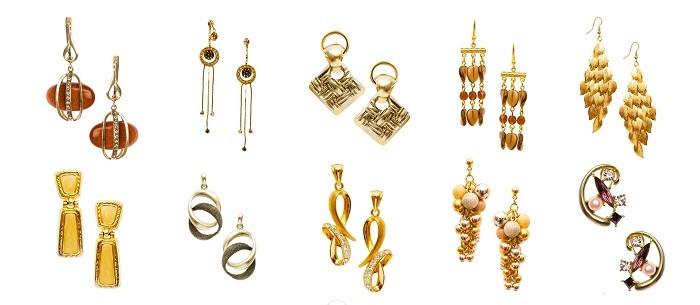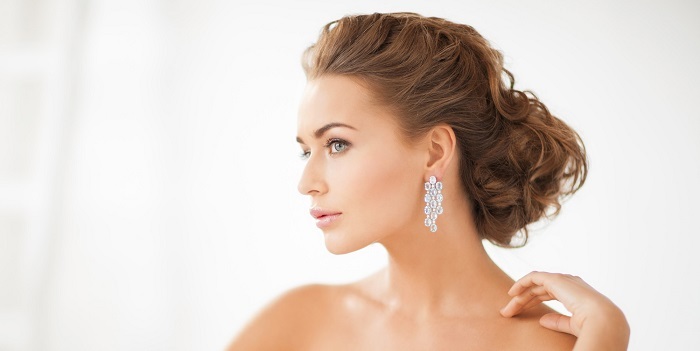

The most popular jewellery style worn worldwide is definitely earrings. Although the term was significantly expanded to encompass decorations worn on other portions of the ear, such as ear cuffs, in the late 20th century, it still mostly refers to jewellery worn affixed to the earlobes.
Even when rings are worn through piercings in other body areas, such as the nose, they are used to indicate jewellery in ring form. Earrings are worn by both men and women nowadays, whether they are fancy hoops made of precious metals for haute couture, quirky studs, or the gauge earrings that are fashionable among young people. Piercing holes in the earlobes through which a loop or post could be threaded has traditionally been the most popular method of attaching earrings to the lobes. However, a number of other tools have also been employed, such as spring clips, tensioning tools like screw backs, and, for exceptionally heavy earrings, loops that pass over the top of the ear or fasten to the hair or headdress.

Given how common they are; parents frequently pierce the ears of their young daughters so they can become acclimated to wearing earrings from an early age. Earlobes are a natural location to decorate, and humans have been doing so long before the start of written history. Earrings have historically been used in numerous civilizations all over the world to signify status, tribal identity, or cultural identity. However, earrings’ popularity has typically been attributed to their decorative qualities. Since most of us glance at someone’s face when we speak to them, earrings are a clear indication of someone’s status, sense of fashion, or level of money.
The history of earrings dates back more than 7,000 years to ancient Asia. The earliest archaeologically documented earrings are crescent-shaped gold hoops worn by Sumerian women around 2500 BCE. By the year 1000 BC, the Aegean region and Western Asia were awash in tapered hoop earrings, also known as boat-shaped earrings. These earrings were most frequently made of gold, but they were also made of silver and bronze. In Crete and Cyprus, earrings were adorned with twisted gold wire, beads, and pendants that were stamped from thin sheets of gold.
Ancient Egyptians used to wear earrings to denote their riches or higher social level. However, only slaves and prostitutes wore earrings in ancient Rome and Greece, respectively. Male earrings were both in and out of style during the Middle Ages in Europe. Wealthy people in Rome and Greece would also wear earrings set with pearls and other pricey stones to demonstrate their social status. The truth is that earrings are quite outdated. They were also mostly worn by men, which is not surprising given that men have held money for the majority of history. Egyptian gold earrings from the 19th Dynasty are on display at the British Museum (1200–1186 BC). Furthermore, there are tomb paintings of New Kingdom men and women wearing earrings (1550–1070 BC). The earrings frequently discovered in the tombs of child kings, however, have led some archaeologists to hypothesise that earrings may have been worn predominantly by children. Additionally, wall carvings from the ancient city of Persepolis, the Achaemenid Empire’s capital (550–330 BCE), reveal that Persian men wore earrings there.
According to the idea that individuals cannot alter their bodies because they were formed in God’s image, the Catholic Church, however, outlawed ear piercing in the 13th century. Earrings rose in popularity during that time among criminals, pirates, and the lower classes. People began to disregard church regulations soon after the Renaissance. Young boys with pierced ears and the family’s lone boy both belong to single mothers whose husbands have been dead. A man with earrings in both ears was the last of his family line, and as such, he would not be permitted to take part in times of war for fear that his family name would be lost forever.
In the 17th, 18th, and 19th centuries, earrings fluctuated in popularity with women’s fashions. For instance, women in the 18th century wore big bonnets that concealed their fashions. For instance, women in the 18th century wore big bonnets that concealed their ears. Earrings, however, returned in style when women started wearing their hair upswept in the 19th century. Later in the 19th century, when Victorian values took over in England, body piercing was classified as a filthy habit. It wasn’t until the 1950s that ear piercing became widely popular in the United States. Many people thought earrings were rude throughout the early part of the 20th century, though the clip-on kind was more acceptable. The movie Grease, in which Sandy has her ears pierced by her not-so-good girl friends, highlights the shift in “good girls” getting their ears pierced.
Earrings have long been worn in many situations and civilizations as indicators of age, marital status, rank, or cultural or tribal identification, as well as because they are thought to have healing or protecting properties. However, earrings have always primarily been worn for ornamental purposes, even when they have been used for other purposes. The fact that earrings are prominently worn so close to the face and at the intersection of costume and hairstyle makes them perhaps more responsive to changes in fashion than any other piece of jewelry.

As hairstyles, hats, collars, and necklines have changed, earrings have correspondingly grown and shrunk in size and prominence, and during many time frames they have been essential in adjusting and tying together all desired fashionable appearances.
Piercings are now quite common among both men and women, not just in the earlobes but also in other regions of the body. Earrings are now available in more styles than ever before for both men and women. Everybody can find something they like, whether it’s expensive earrings from a jeweller like Noe’s or quirky costume designs from a private website. Earrings now have a massive market due to the increasing acceptance of ear piercing, which contributes to their relative design diversity. Even though they are still far less frequent than the typical ear piercing, asymmetric double piercing and cartilage piercing have gained popularity.